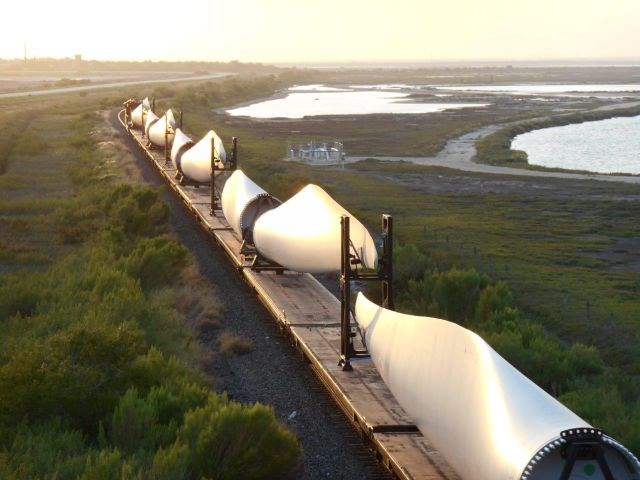BNSF Logistics and TTS cut wind blade transport costs
BNSF's Blade Runner service uses a single universal fixture for ocean, rail, truck and storage improving clearance, load factors and efficiency while TTS uses high density fixture to pack 42 blades per train.
BNSF Logistics (Flower Mound, TX, US) announced the successful testing of its innovative new fixtures developed to move wind turbine blades more efficiently. The Blade Runner service is a universal fixture designed for rail and ocean transport to optimize movement of wind components between any two points in the world. With the ratio of logistics costs for Wind projects running at nearly 2X other industries, and with strong interest from manufacturers, developers and OEMs seeking options for handling increasingly longer blades, BNSF Logistics teamed up with Energo (Houston, TX US), an engineering and design company with a long history in the Wind sector. Together, they have developed transport fixtures that will greatly increase efficiency and drive down logistics costs. The developed fixtures (patent pending) and handling solutions will benefit customers for both international and U.S. domestic moves.
Using the same technology for ocean, rail, truck and storage will allow blades to move without the need for attached fixtures, which have historically been both expensive and difficult to manage. "The Wind Energy sector has depended on decade-old methods that are increasingly irrelevant as global sourcing and the size of blades increase,” says Ray Greer, BNSF Logistics’ president. “Our universal fixtures for both ship and rail transport modernizes the wind logistics industry and will unshackle current logistics constraints facing the industry, getting the wind industry closer to that critical self-sustaining cost level.”
The universal rail fixtures are designed to handle blades of all sizes including increasingly longer blades inside the clearance windows required, making rail a viable option versus truck. This is a critical development as truck capacity is projected to be a real challenge as wind projects accelerate in 2015 and beyond. Multiple rail tests were conducted on blades over 45m in length at the Port of Corpus Christi, TX, US. The results showed a 35% improvement of clearance envelope making rail a viable mode choice for almost any North American destination.
After successful testing of the new ocean blade stowage design, BNSF Logistics estimates stowage rates to increase by a minimum of 25% over existing configurations. Additional efficiencies and direct cost reductions have been validated and details shared with potential customers under confidentiality agreements.
Industry feedback has been extremely positive. John Billingsley, CEO of Tri Global Energy, says, “Reducing all-in project building costs is an essential goal in the highly competitive electric utility power generation industry. Reducing logistics costs in our wind energy projects by using BNSF Logistics’ new shipping solutions will have a very meaningful impact on achieving that goal.”
Use of the new fixture designs is expected to begin in the second quarter of 2015 and will ramp up as quickly as manufacturing of the fixtures will allow. The impact on costs and efficiency will be realized immediately and could make previously unattractive areas more viable for wind project development.
Meanwhile, Transportation Technology Services (Southlake, TX, US) has developed its HD (High Density) Universal Blade Train fixture and configuration allows customers to ship 48 blades of 50m length on a single 72 car unit train. The newly designed stacking tip stand on the HD Universal blade train resulted in a 33% load increase over previously used loading methods reducing shipping costs. The first two HD Universal blade trains successfully delivered blades from Corpus Christi, TX to a wind farm in Kansas in the fall of 2014. Currently, there are two of these trains moving, and there are plan to additional ones in 2015.
Related Content
JEC World 2022, Part 3: Emphasizing emerging markets, thermoplastics and carbon fiber
CW editor-in-chief Jeff Sloan identifies companies exhibiting at JEC World 2022 that are advancing both materials and technologies for the growing AAM, hydrogen, automotive and sustainability markets.
Read MoreJEC World 2022, Part 1: Highlights in sustainable, digital, industrialized composites
JEC World 2022 offered numerous new developments in composites materials, processes and applications, according to CW senior editor, Ginger Gardiner, most targeting improved sustainability for wider applications.
Read MoreMaterials & Processes: Fibers for composites
The structural properties of composite materials are derived primarily from the fiber reinforcement. Fiber types, their manufacture, their uses and the end-market applications in which they find most use are described.
Read MoreMaterials & Processes: Composites fibers and resins
Compared to legacy materials like steel, aluminum, iron and titanium, composites are still coming of age, and only just now are being better understood by design and manufacturing engineers. However, composites’ physical properties — combined with unbeatable light weight — make them undeniably attractive.
Read MoreRead Next
CW’s 2024 Top Shops survey offers new approach to benchmarking
Respondents that complete the survey by April 30, 2024, have the chance to be recognized as an honoree.
Read MoreComposites end markets: Energy (2024)
Composites are used widely in oil/gas, wind and other renewable energy applications. Despite market challenges, growth potential and innovation for composites continue.
Read MoreFrom the CW Archives: The tale of the thermoplastic cryotank
In 2006, guest columnist Bob Hartunian related the story of his efforts two decades prior, while at McDonnell Douglas, to develop a thermoplastic composite crytank for hydrogen storage. He learned a lot of lessons.
Read More
















.jpg;maxWidth=300;quality=90)









